You are using an out of date browser. It may not display this or other websites correctly.
You should upgrade or use an alternative browser.
You should upgrade or use an alternative browser.
Quick luthiery/manteinance questions not deserving a thread
- Thread starter OmegaSlayer
- Start date
This site may earn a commission from merchant affiliate links like Ebay, Amazon, and others.
This site may earn a commission from merchant links like Ebay, Amazon, and others.
Quick question. Could this disaster of a binding be fixed? Would the cost be worth it? This is an ESP E-II, BTW.
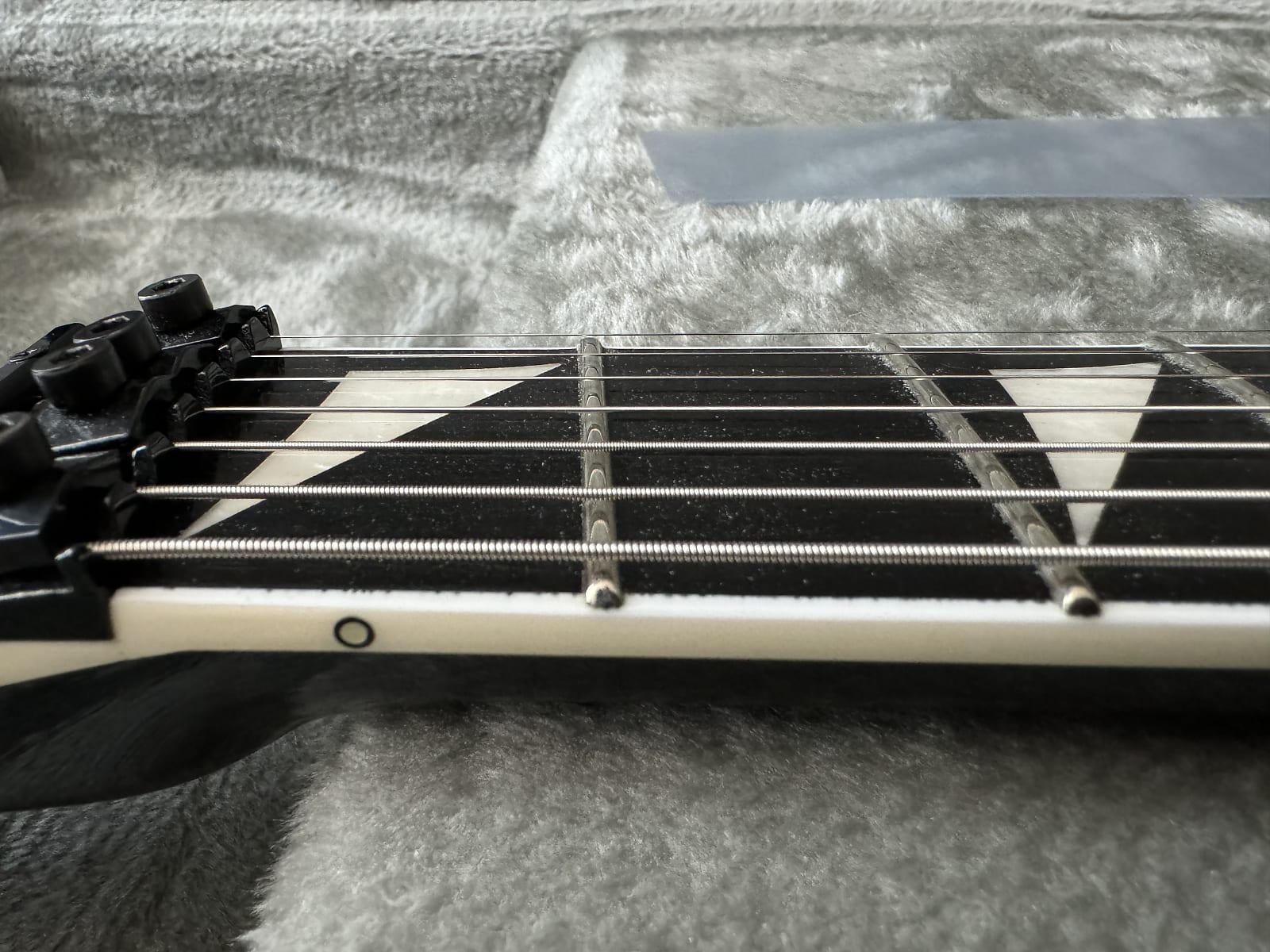
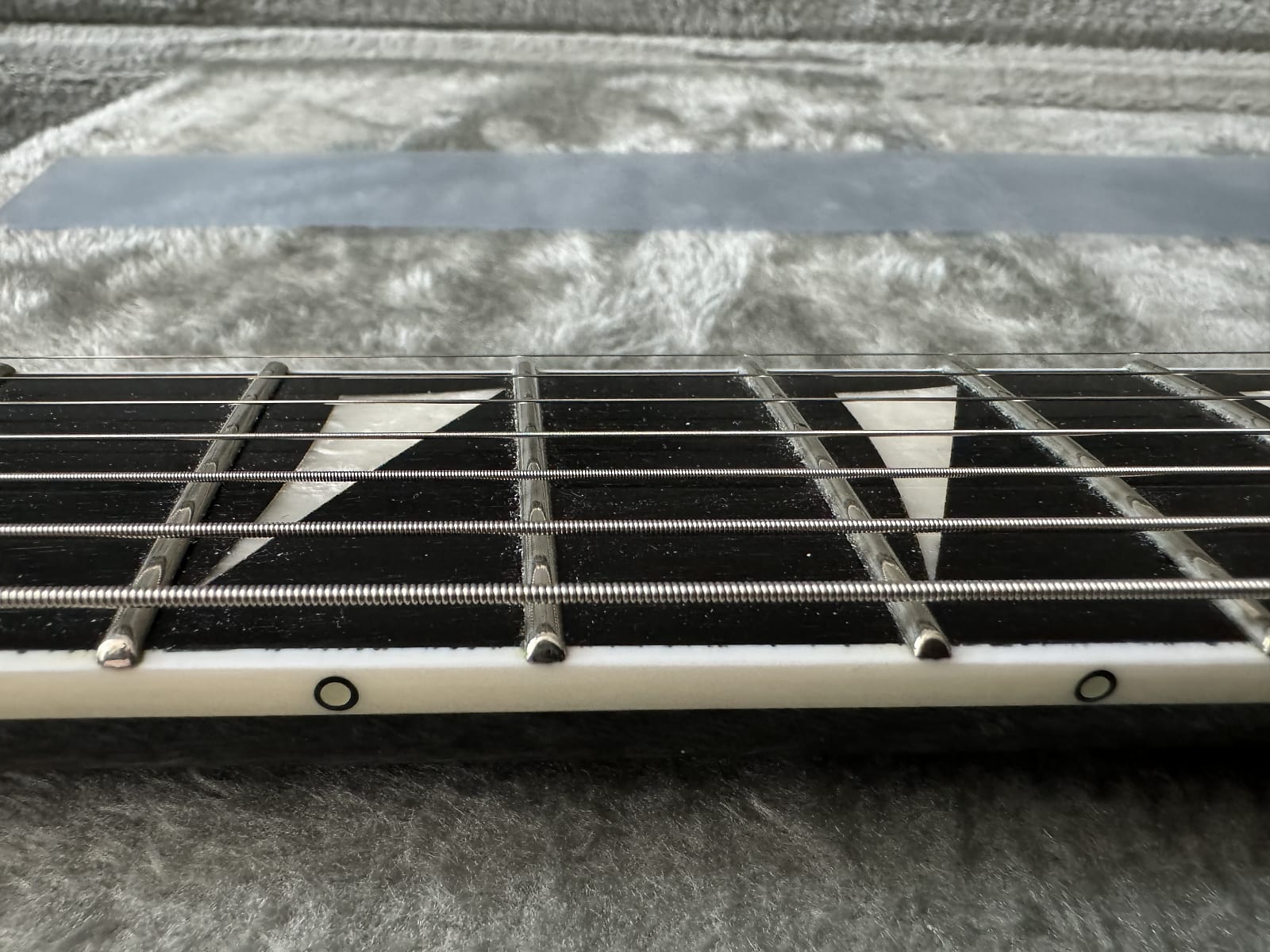
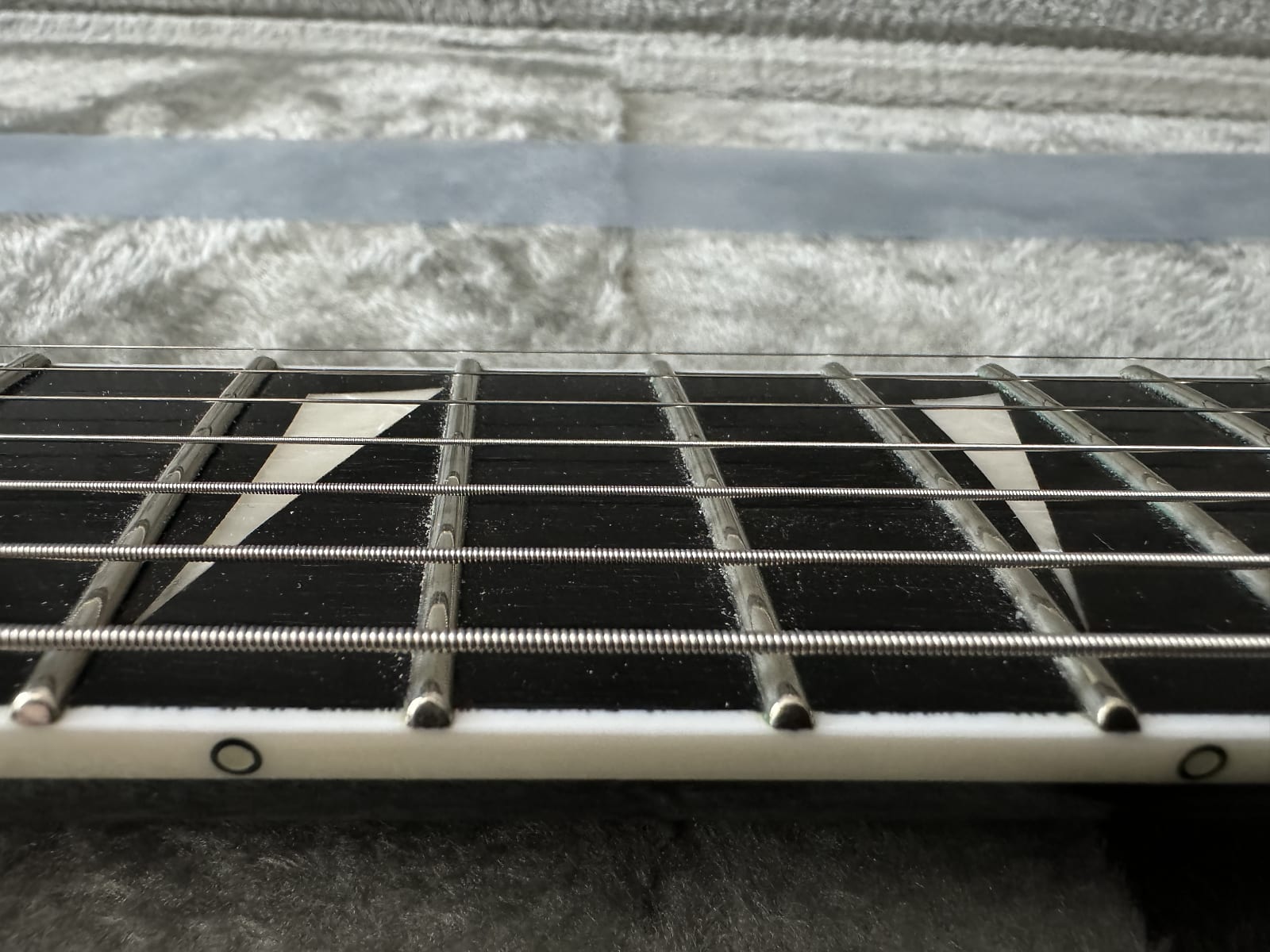
Is that just dye creep under the finish? A razor blade should make quick work of it.
JimF
Contributor
I hope the the poster's sake its dye creep, I thought it was a raggedy toolmarked edge
The guitar is not mine, but listed for sale. I was interested until I saw that. I guess I don't have any way to know if it's dye creep or not since apparently the seller didn't even notice (he was the one that asked me if it's fixable).
The guitar is not mine, but listed for sale. I was interested until I saw that. I guess I don't have any way to know if it's dye creep or not since apparently the seller didn't even notice (he was the one that asked me if it's fixable).
I can't imagine it being anything else. It's not on the board, just the binding, and it's pitch black. So it's not glue or anything. But either case, a good scrape should clear it up if you don't want to just wait for wear to do the job.
I can't imagine it being anything else. It's not on the board, just the binding, and it's pitch black. So it's not glue or anything. But either case, a good scrape should clear it up if you don't want to just wait for wear to do the job.
So can't it be a terribly chopped binding? I asked for more pics just in case:
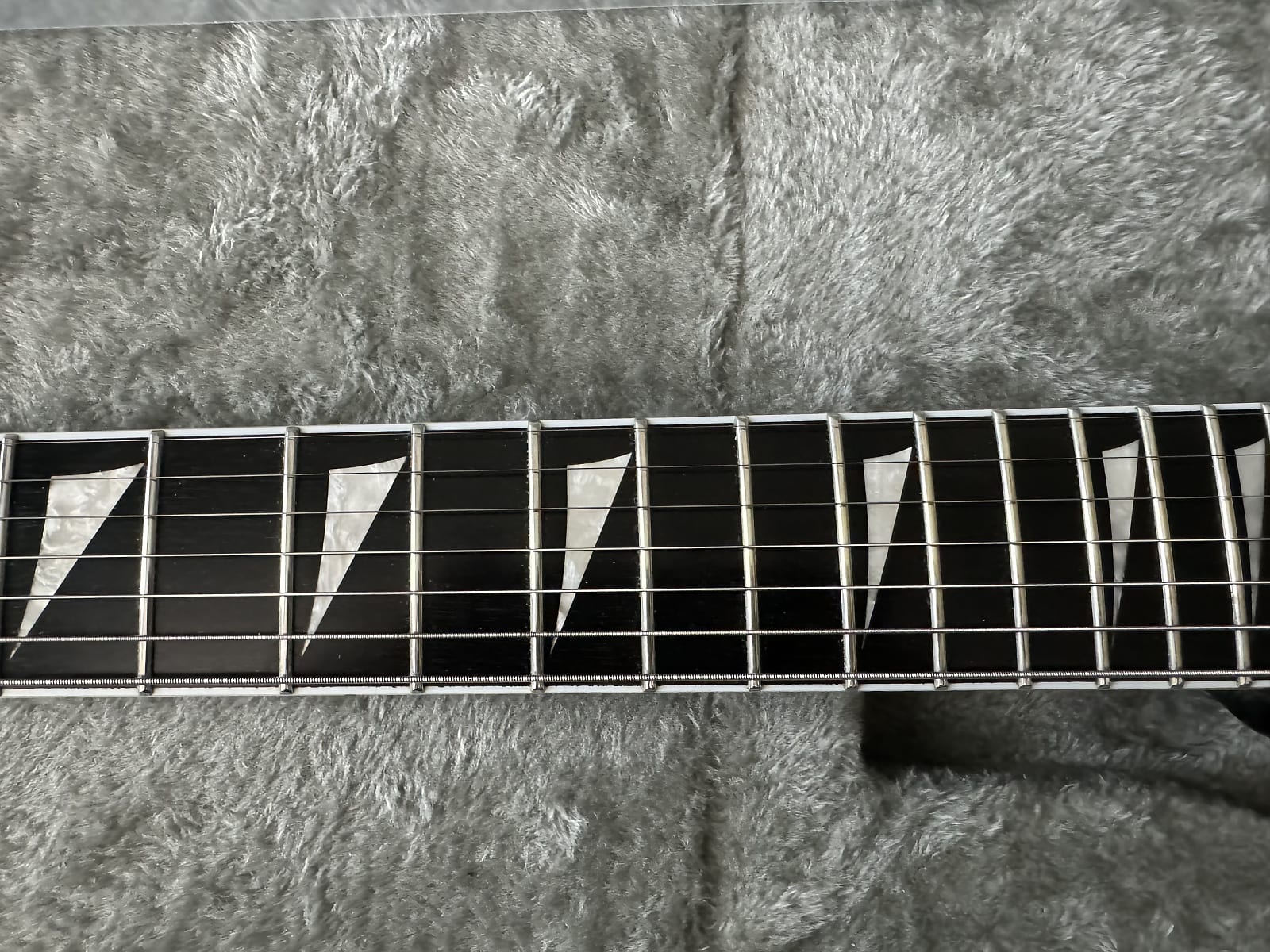
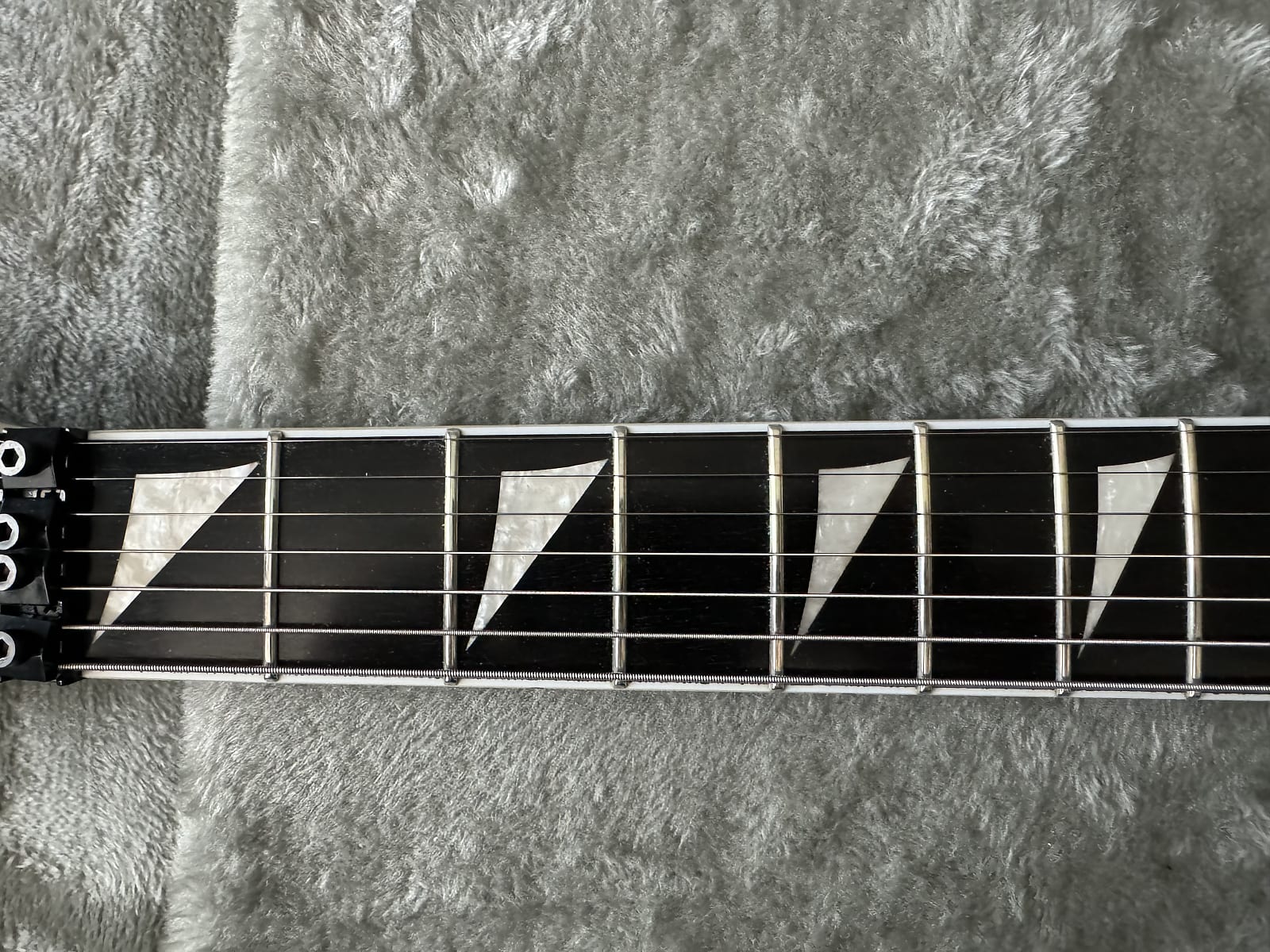
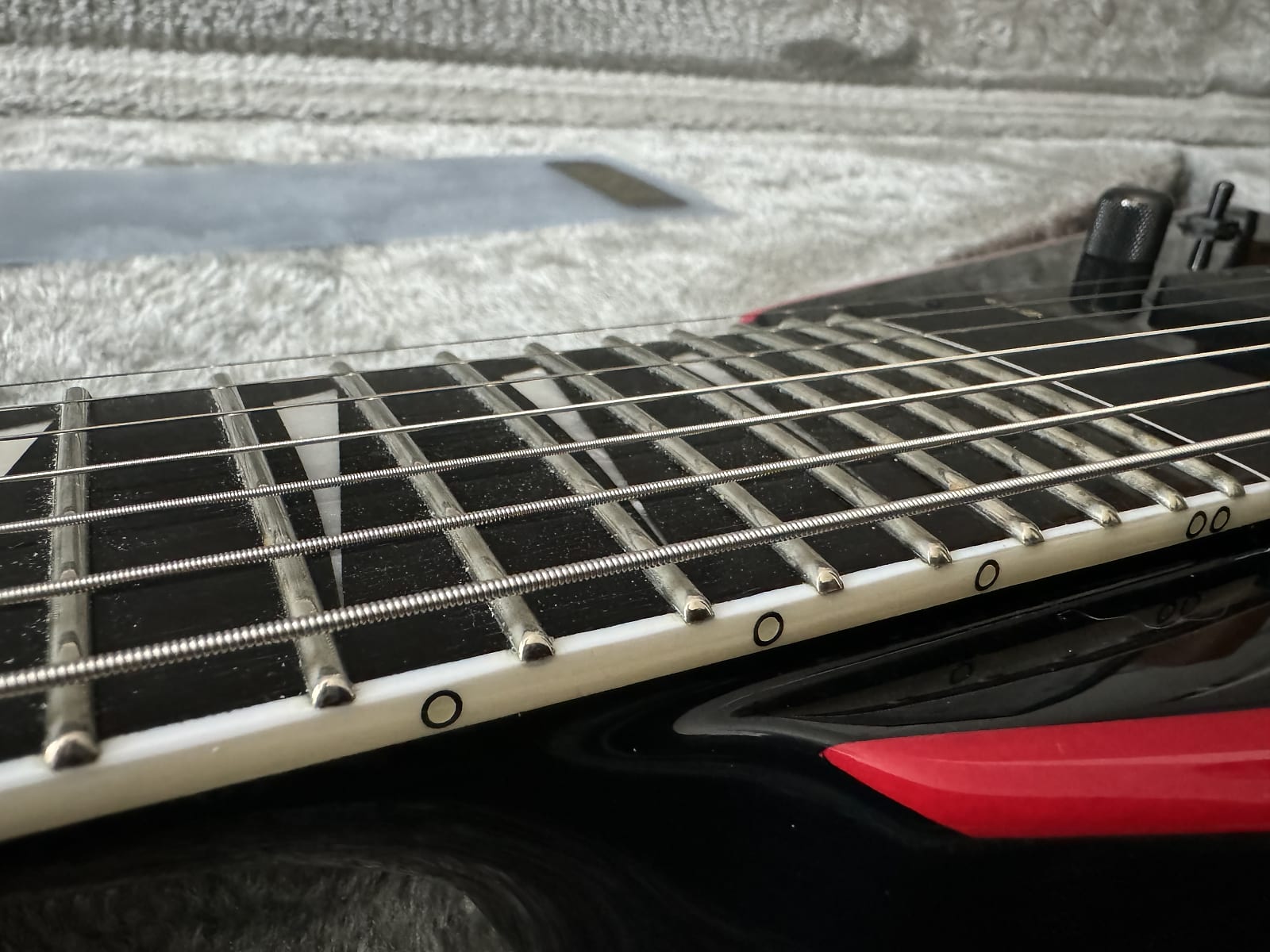
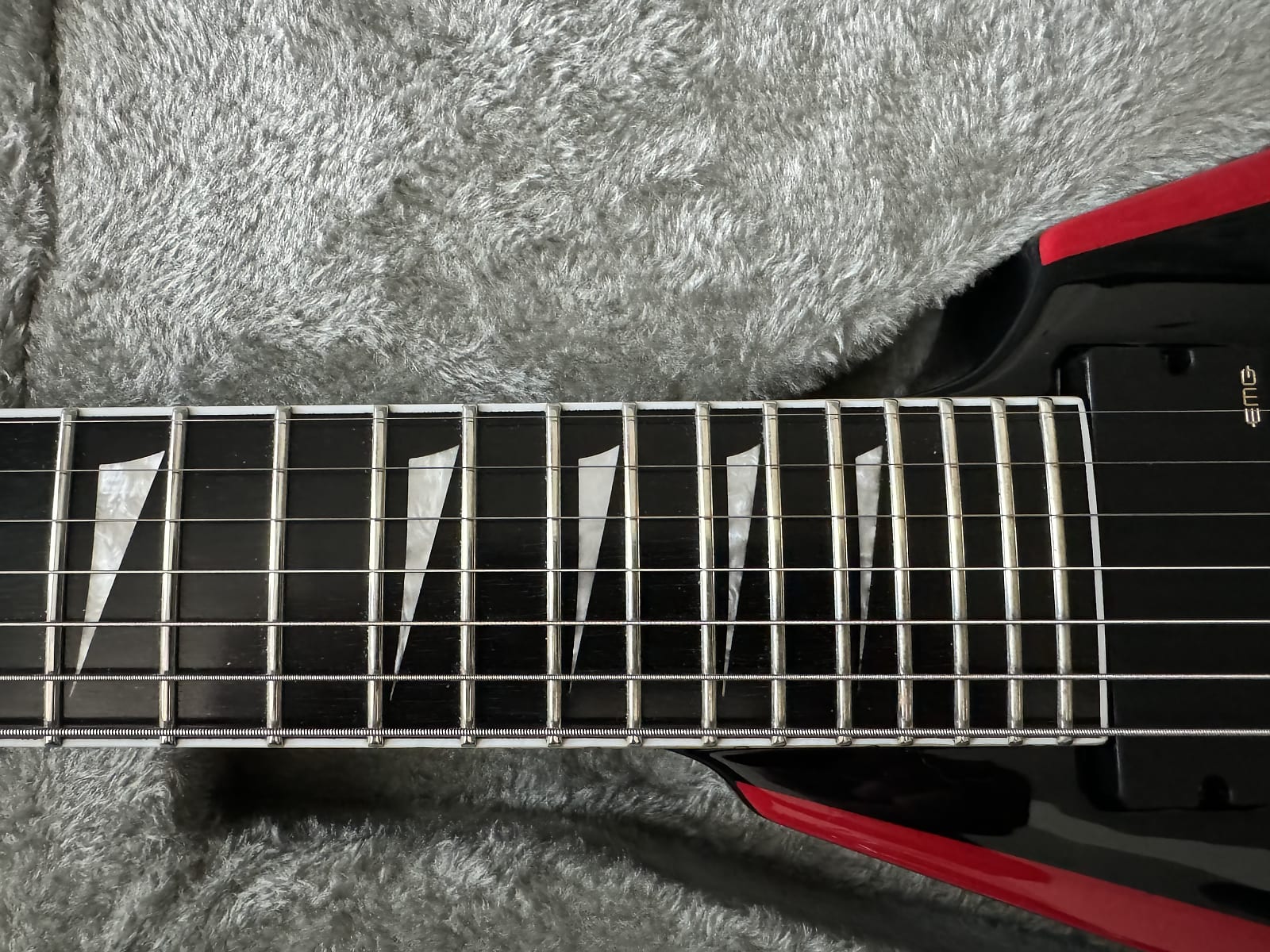
So can't it be a terribly chopped binding? I asked for more pics just in case:




Chopped? By what? How?
Even if they installed it and then sanded it flush it wouldn't chip out so finely and evenly across the whole board.
The surface that lays against the board is flat to begin with so I don't see why they'd mess with it like this. Even running over a file for better glue adhesion wouldn't be that bad.
When in doubt pass on it, but from the "meh" pics this looks more surface level from what I've seen in the past.
I meant chippedChopped? By what? How?
Even if they installed it and then sanded it flush it wouldn't chip out so finely and evenly across the whole board.
The surface that lays against the board is flat to begin with so I don't see why they'd mess with it like this. Even running over a file for better glue adhesion wouldn't be that bad.
When in doubt pass on it, but from the "meh" pics this looks more surface level from what I've seen in the past.

Well, if it's easily fixable I might still be interested if it goes down in price, but my first reaction was to tell the seller he should properly disclose the issue on the listing. Nobody wants to deal with returns.
Thanks for the insight. As you can tell I know little about building guitars (which is why I posted here).
I asked this on talkbass and await info, so I figure ill drop it here too.
Richlite fretless fingerboards. Are they susceptible to the same high/low spots as traditional wood boards when mated to a maple shaft?
Mine has overtones and buzzy spots in many locations that can not be fixed with any value of neck relief and/or string height.
Wondering if it needs leveling or if there's some weird sympathetic resonance going on with the hardware or truss rod. I cannot isolate either confidently as an explanation.
It sounds like the notes in certain spots have way too much bloom/overtone.
Richlite fretless fingerboards. Are they susceptible to the same high/low spots as traditional wood boards when mated to a maple shaft?
Mine has overtones and buzzy spots in many locations that can not be fixed with any value of neck relief and/or string height.
Wondering if it needs leveling or if there's some weird sympathetic resonance going on with the hardware or truss rod. I cannot isolate either confidently as an explanation.
It sounds like the notes in certain spots have way too much bloom/overtone.
I asked this on talkbass and await info, so I figure ill drop it here too.
Richlite fretless fingerboards. Are they susceptible to the same high/low spots as traditional wood boards when mated to a maple shaft?
Mine has overtones and buzzy spots in many locations that can not be fixed with any value of neck relief and/or string height.
Wondering if it needs leveling or if there's some weird sympathetic resonance going on with the hardware or truss rod. I cannot isolate either confidently as an explanation.
It sounds like the notes in certain spots have way too much bloom/overtone.
It should be pretty easy to check with a straight edge and a good light source.
Straighten the neck, place bass on a flat surface, place straight edge on board. Place your light source, a cheap LED lantern works well, on the other side of the bass and turn the room lights off.
If the neck is dead straight and you see light through gaps on the board along the string paths that means the surface of the board isn't dead flat.
Ordacleaphobia
Shameless Contrarian
So not directly luthiery related, but somewhat along that line.
I've [very] recently taken up woodworking and joinery as a hobby with the eventual goal of building my own guitar. Nothing crazy, just something that looks the way I want it, made out of what I want it made out of, that's remotely playable that I can pick up and think 'I made this.'
Which is likely quite a far away goal at the moment.
But, those of you that have already made that trek; share with me your wisdom. What did you learn along the way that was applicable, what came in handy? What techniques, tools, and nuggets of knowledge did you find most useful when you started building? If I'm going to be tackling a ton of projects to learn the ropes, I'd like to try and take stuff on that will teach me what I'll need to know when I eventually decide to try my hand at it. It's a whole new world for me that I'm just dipping my toes into so I am a blank slate at the moment.
A lot of you guys are wicked talented so I'd feel silly not seeking your advice.
I've [very] recently taken up woodworking and joinery as a hobby with the eventual goal of building my own guitar. Nothing crazy, just something that looks the way I want it, made out of what I want it made out of, that's remotely playable that I can pick up and think 'I made this.'
Which is likely quite a far away goal at the moment.
But, those of you that have already made that trek; share with me your wisdom. What did you learn along the way that was applicable, what came in handy? What techniques, tools, and nuggets of knowledge did you find most useful when you started building? If I'm going to be tackling a ton of projects to learn the ropes, I'd like to try and take stuff on that will teach me what I'll need to know when I eventually decide to try my hand at it. It's a whole new world for me that I'm just dipping my toes into so I am a blank slate at the moment.
A lot of you guys are wicked talented so I'd feel silly not seeking your advice.
I am not talented but what helped me take the plunge was to find a video series on building a guitar from A to Z I liked watching. Then, just dive into it and learn along the way.
But the eureka moment for me was stopping to underestimate hand tools. A router is all I need if I have sharp hand tools.
But the eureka moment for me was stopping to underestimate hand tools. A router is all I need if I have sharp hand tools.
JimF
Contributor
A router really makes the difference in how clean the outline of your build is. I've seen plenty of builds done without a router & template and you can spot the amateur-ness a mile away.
Also, don't get overwhelmed by the sheer amount of stuff to do, building a guitar is a series of simple but precise operations.
Also, don't get overwhelmed by the sheer amount of stuff to do, building a guitar is a series of simple but precise operations.
So not directly luthiery related, but somewhat along that line.
I've [very] recently taken up woodworking and joinery as a hobby with the eventual goal of building my own guitar. Nothing crazy, just something that looks the way I want it, made out of what I want it made out of, that's remotely playable that I can pick up and think 'I made this.'
Which is likely quite a far away goal at the moment.
But, those of you that have already made that trek; share with me your wisdom. What did you learn along the way that was applicable, what came in handy? What techniques, tools, and nuggets of knowledge did you find most useful when you started building? If I'm going to be tackling a ton of projects to learn the ropes, I'd like to try and take stuff on that will teach me what I'll need to know when I eventually decide to try my hand at it. It's a whole new world for me that I'm just dipping my toes into so I am a blank slate at the moment.
A lot of you guys are wicked talented so I'd feel silly not seeking your advice.
There are like 1000000 ways to do just about every function of making and working on guitars. Find the way that works for you, not just what gets you the best results, but what's also the most engaging and rewarding.
Remember, this is supposed to be fun. If you're not having fun step back and think about why.
Tools and techniques mean very little compared to your own skills and ingenuity. I've seen guys make museum quality instruments with yard sale hand tools on their kitchen counter and guys with quarter million dollar workshops churn out junk.
Don't be too hard on yourself when you're starting. You will screw up and things will not turn out to plan every time, but those are vital learning experiences.
It's better to master simple fundamentals then to go off half cocked on fancy stuff. Make great necks with great fretwork.
Captain Shoggoth
Gotoh 1996T shill
Having a persistent problem with the Floyd saddle (OFR) on the low B string of one of my 7s. Once I start tuning up (not even arriving at pitch), the string starts to slack, eventually the wraps begin to unwind where it comes out from the saddle, rendering the string and thus the guitar completely unusable.
Clearly the general thickness of the 7th string is a contributing factor given that the other 6 are fine (and I've had milder such experiences with low Bs on other guitars), I've tried different gauges and brands of strings and the issue persists. I thought maybe I was overtightening the screws, but if I apply any less pressure then as soon as I start to tune up the *seemingly* secure string pops right out the saddle.
I bought the guitar used but it was fine on arrival, the problem only cropped up after I'd had it a few months.
Took it to my usual guy when it first started happening, he couldn't visually identify anything but figured there was a burr on the saddle and sanded it down (right through the finish to the metal) with abrasive cord, which fixed the problem... for a couple months. By 6 months later it's as bad as it ever was.
AB'd the saddle insert against other OFR inserts with 0 success. I'm using titanium locking screws with the stock inserts but I can't see how that could cause any issues short of the blocks themselves cracking, which hasn't happened - they're all structurally intact.
Stumped as to what to do. Floyd don't sell single low B saddles so I'd have to buy a whole set, which would be a costly gamble - if I could even find a set to begin with.
Clearly the general thickness of the 7th string is a contributing factor given that the other 6 are fine (and I've had milder such experiences with low Bs on other guitars), I've tried different gauges and brands of strings and the issue persists. I thought maybe I was overtightening the screws, but if I apply any less pressure then as soon as I start to tune up the *seemingly* secure string pops right out the saddle.
I bought the guitar used but it was fine on arrival, the problem only cropped up after I'd had it a few months.
Took it to my usual guy when it first started happening, he couldn't visually identify anything but figured there was a burr on the saddle and sanded it down (right through the finish to the metal) with abrasive cord, which fixed the problem... for a couple months. By 6 months later it's as bad as it ever was.
AB'd the saddle insert against other OFR inserts with 0 success. I'm using titanium locking screws with the stock inserts but I can't see how that could cause any issues short of the blocks themselves cracking, which hasn't happened - they're all structurally intact.
Stumped as to what to do. Floyd don't sell single low B saddles so I'd have to buy a whole set, which would be a costly gamble - if I could even find a set to begin with.
Last edited:
Having a persistent problem with the Floyd saddle (OFR) on the low B string of one of my 7s. Once I start tuning up (not even arriving at pitch), the string starts to slack, eventually the wraps begin to unwind where it comes out from the saddle, rendering the string and thus the guitar completely unusable.
Clearly the general thickness of the 7th string is a contributing factor given that the other 6 are fine (and I've had milder such experiences with low Bs on other guitars), I've tried different gauges and brands of strings and the issue persists. I thought maybe I was overtightening the screws, but if I apply any less pressure then as soon as I start to tune up the *seemingly* secure string pops right out the saddle.
I bought the guitar used but it was fine on arrival, the problem only cropped up after I'd had it a few months.
Took it to my usual guy when it first started happening, he couldn't visually identify anything but figured there was a burr on the saddle and sanded it down (right through the finish to the metal) with abrasive cord, which fixed the problem... for a couple months. By 6 months later it's as bad as it ever was.
AB'd the saddle insert against other OFR inserts with 0 success. I'm using titanium locking screws with the stock inserts but I can't see how that could cause any issues short of the blocks themselves cracking, which hasn't happened - they're all structurally intact.
Stumped as to what to do. Floyd don't sell single low B saddles so I'd have to buy a whole set, which would be costly and wasteful - if I could even find a set to begin with.
The old trick for this is to tin the end of the string with some solder to hold it together.
Captain Shoggoth
Gotoh 1996T shill
The old trick for this is to tin the end of the string with some solder to hold it together.
Thanks for the tip, gonna try this. Not sure how practical it'd be for touring though, unless did it in batches beforehand I guess. I get mine from Winspear so might ask if he'd consider pre-doing them on a bulk order.
OmegaSlayer
Well-Known Member
I'm probably picking a guitar that has a recessed Floyd.
I'd like to install a DTuna on it as I'm planning to pick (in due time) 3 guitars and have DTuna on them and different tuning (E, Eb and D) because I don't want to keep guitars in drop tuning all the time as I don't like the feel of playing in drop tuning.
I looked around a bit and noticed that people usually put DTuna on Floyd that are not recessed, more on that, they advise against installing it, and I see the problem with the DTuna going to hit the body when pulling up the bar (except on the Washburn N4).
I'm probably never going to pull out wild whammy antics a la Vai, just subtle things and most of all lowering the pitch, so I wonder if anyone else has a DTuna on a recessed Floyd and if it is really a problem.
I'd like to install a DTuna on it as I'm planning to pick (in due time) 3 guitars and have DTuna on them and different tuning (E, Eb and D) because I don't want to keep guitars in drop tuning all the time as I don't like the feel of playing in drop tuning.
I looked around a bit and noticed that people usually put DTuna on Floyd that are not recessed, more on that, they advise against installing it, and I see the problem with the DTuna going to hit the body when pulling up the bar (except on the Washburn N4).
I'm probably never going to pull out wild whammy antics a la Vai, just subtle things and most of all lowering the pitch, so I wonder if anyone else has a DTuna on a recessed Floyd and if it is really a problem.
I'm probably picking a guitar that has a recessed Floyd.
I'd like to install a DTuna on it as I'm planning to pick (in due time) 3 guitars and have DTuna on them and different tuning (E, Eb and D) because I don't want to keep guitars in drop tuning all the time as I don't like the feel of playing in drop tuning.
I looked around a bit and noticed that people usually put DTuna on Floyd that are not recessed, more on that, they advise against installing it, and I see the problem with the DTuna going to hit the body when pulling up the bar (except on the Washburn N4).
I'm probably never going to pull out wild whammy antics a la Vai, just subtle things and most of all lowering the pitch, so I wonder if anyone else has a DTuna on a recessed Floyd and if it is really a problem.
The D-Tuna works because when you lower the tuning to D, and reduce tension, the bridge rests on the top of the guitar, because it's dive only/non-recessed, thus keeping the other strings in tune and bridge at proper level.
On a recessed/full floating unit if the bridge doesn't rest properly using the D-Tuna throws the guitar out of tune.
Some guitars with full floating bridges are designed to work with the D-Tuna, having the necessary route and neck angle to accommodate its use, so it's not impossible, but is instrumental specific.
OmegaSlayer
Well-Known Member
Thanks @MaxOfMetal
I figured the jist of it out now.
The DTuna works because the bridge can't go further because of the guitar body.
Simplier than I thought, I believed it was some more exotical space magic
I figured the jist of it out now.
The DTuna works because the bridge can't go further because of the guitar body.
Simplier than I thought, I believed it was some more exotical space magic
